Extracted and edited from the Far Eastern Review, May 1924 edition
“Hongkong’s Contribution to the Empire” was the headline in the May 1924 edition of “The Far Eastern Review”, a monthly journal dedicated to the Industrial Development and Advancement of Trade in Far Eastern Countries.
So highly regarded and prestigious was this journal to the intelligence communities of foreign countries, dozens of copies were shipped off around the world from Shanghai each month, ensuring that secret services agents, such as those sitting in dust offices in Europe and the Americas had plenty of photographs, in-depth descriptions of China and the Far East, as well as the latest exchanges then circulating among the political classes of these far-distant locations.
One of the important features contained within the May 1924 edition was an article on the Taikoo Dockyard, Hong Kong. This was intended to run in parallel with the British Empire Exhibition, held at Wembley in England, from 23rd April 1924 to 31st October 1925. The Taikoo Dockyard, and its competitor, The Hongkong and Whampoa Dock Co. had together created a large Far Eastern shipbuilding industry in Hong Kong, building ships for the then great British Empire, far and wide.
One of the most interesting exhibits at the show was a scale model of the Taikoo Shipyard, which was also supplemented by numerous photographs, plans and an array of other promotional material, pertinent at the time.
The Taikoo dockyard was built between 1902 and 1907. Its large, granite-lined dock was 787ft in length, almost 82 ft in width and could accommodate most of the world’s largest commercial and naval ships of the era, having been built to British naval specifications.
It was customary in the days of the Empire, for their Colonial companies to buy almost exclusively from the ‘home country’. It is no coincidence therefore, between 1901 and 1902, parent company Butterfield and Swire placed an order for two small steam locomotives from the Manning Wardle Company’s Boyne Engine Works in Leeds. The two engines of 0-6-0 wheel configuration were ‘saddle’ tank engines, which to non-railway buffs means that the water tank is placed over the top and around the sides of the boiler as if it were a saddle on a horse or donkey. The factory Works Nos. were 1514 and 1578 of 1901 and 1902, respectively. The wheel gauge of the locomotives being 4ft. 8½ins., at that time known internationally as ‘standard gauge’. These two steam locomotives were used throughout the dockyard, hauling steel, other materials and components between the construction slipway and the various other sites within the yard, connected by the rail network.
One of the original surviving saddle tank steam engines, used at Taikoo Shipyard, seen above at work in the shipyard and now used on the Middleton Railway in Leeds, close to the very site where the engine was constructed over one hundred years ago
As part of the ‘Contribution to the Empire’, there follows a random review of a few of the ships built at these dockyards, some of which could each merit their own interesting forum topic, with tales of piracy, kidnappings, arson, typhoon stranding, groundings on many of the South China Sea’s notorious reefs, by negligent or perhaps drunken Masters. Later the target of torpedo attacks or colliding with mines during the Second World War.
After completion, Taikoo Dockyard (above) was building, on average, about six medium size steamships a year, mostly for Chinese coast and river trades. Shortly before the British Empire Exhibition, the dockyard achieved much publicity after completing an overhaul of the Empress of Canada (length 627 ft) in their dock, which was considered a large vessel for the time.
Some of the scheduled services operated by China Navigation Company at the time included:
- Hong Kong-Manila, Cebu and Iloilo
- Hankow-Shanghai and Siangtan
- Hong Kong-Haiphong
- Hankow-Ichang
- Hong Kong-Bangkok
- Shanghai-Ningpo
- Hong Kong-Canton
- Shanghai-Antung
- Shanghai-Hong Kong
- Canton-Shanghai-Tsingtao
- Shanghai -Tianjin
- Shanghai-Hankow
Several editions of the FER during the 1920s featured ships which had been built at Taikoo dockyard as well as the Hongkong and Whampoa Company’s shipyards.
SS Nanning
The 2,485 grt Nanning was built by Taikoo Shipyard & Engineering Co. in 1923 for the China Navigation Co. She was scuttled at Hong Kong in December 1941 to avoid capture by Japanese forces. However, the ship was salvaged, repaired and renamed Nannin Maru, perhaps a mis-spelling of Nanning? She was sunk again by a mine on the 16th July 1945 off Yawata in northern Kyushu.
River Steamer Hang Cheong
The 1,086 grt River Steamer Hang Cheong was built by Taikoo Dockyard in 1923 for a Macau company, the Yau Tak Steamship Co., and used for river journeys up the Pearl River to Canton. During the war, the Japanese renamed this ship Kaishu Maru and in 1945 she was renamed Hai Chu. On 8th November 1945 she hit a mine off Hong Kong while on a voyage from Canton to Hong Kong carrying troops.
River Steamer Wenchow
The 3,113 grt River Steamer Wenchow (2) was built by Taikoo Dock in 1923 for use on the Yangtze River. This was presumably a replacement for the China Navigation Co.’s original S.S. Wenchow which was broken up in 1922. The first ship of this name was built by Scott & Co. of Greenock in Scotland in 1878. She was taken over by the Japanese in 1942 and renamed Hachigen Maru, then on 14th August 1942 she was torpedoed and sunk by USS Seawolf in the Pacific.
SS Tungchow

The 2,104 grt Tungchow was built in 1914 for China Navigation Co. and for many years served on the Shanghai-Tianjin route. It became famous worldwide, at least twice, for being the subject of pirate attacks in December 1925 and again in February 1935, when 73 foreign children were taken hostage. She was renamed Hsin Peking in 1936 and Rakusan Maru after being taken over by the Japanese Navy in 1941. On 9th August 1945 she was sunk by Allied aircraft off Najin, Korea.
SS Sunning
The 2,555 grt Sunning was built at Taikoo Dockyard in 1916 for China Navigation. On 23rd October 1923, the ship was attacked by pirates near Hong Kong. Master James Pringle, the 1st mate, and an anti-piracy guard were wounded. $20,000 was seized by the pirates.
On 14th March 1926, the Sunning grounded on Button Island and on 15th November 1926 the ship was attacked again by pirates and set on fire between Amoy and Swatow. It was rescued by H.M.S. Bluebell, and towed to Hong Kong for repairs, resuming service on 12th February 1927.
On 27th August 1936, while at anchor at Junk Bay sheltering from a typhoon, she was blown ashore and declared a total loss.
SS Laertes
The 5,806 grt Laertes was built at Taikoo Dockyard in 1919 for Ocean SS Co., part of the Blue Funnel Group. She was torpedoed and sunk by U-109 on 3rd May 1942 when on a voyage from New York and Hampton Roads for Table Bay and Bombay carrying a cargo of 5,230 tons of war supplies, including 3 aircraft, 17 tanks and 20 trucks. 18 crew were lost from a total of 66.
Turbine Steamer Kaying
The 2,626 grt Kaying was built at Taikoo in 1922. She was 321 ft in length and had a beam of 44 ft. The ship was ordered by the China Navigation Co. to operate on their Bangkok trade. The ship had a single propeller shaft driven by ‘Brown Curtis’ type high and low-pressure steam turbine built in-house at the Taikoo Dockyard’s own machine shops. The turbines were driven by steam from a single boiler, fitted for fuel oil, operating at 200 psi. She was torpedoed and sunk by U-593 while on a voyage from Tripoli to Alexandria in balalst.
SS Evangelos
The 5,201 grt Evangelos was launched at the Taikoo Dockyard on 20th May 1919 after being laid down as the War Driver. After its launch, the Evangelos was employed in shipping cargo around post-war Europe. In 1923 she was purchased from the owner, E.E. Ambatielos of London, by Glasgow-based T. Dunlop & Co.’s Queen Line and renamed Queen Maud II. In 1936 she was sold to a Greek company in Piraeus and renamed Christos Markettos. She was torpedoed and sunk by the Japanese submarine I-20 in the Indian Ocean off Mombasa in 1942 with the loss of two lives.
SS Rhexenor
The Rhexenor was launched at the Taikoo Dockyard slipway on 29th July 1922, commissioned for the Blue Funnel Line. She was a freighter of 7,957 grt and 477.5 ft in length.
There follows a description of the vessel by the Far Eastern Review, somewhat dated by their style of drafting the details:
“Under the forecastle has been fitted up for emigrants, while the space under the poop has been utilized for the accommodation of sailors and firemen. Petty officers’ rooms are on the bridge deck alongside the engine casing. In the citadel house at the fore-end of the bridge deck, the saloon, engineers’ rooms, and three staterooms have been arranged, and on the deck over the saloon is a steel house containing the captain’s day and night cabins, also four rooms for officers. Over this house again is the navigating bridge with a wheelhouse and chart room. The vessel is supplied with eighteen steam winches with derricks carrying loads varying from 2 to 40 tons. A powerful Marconi wireless apparatus is installed, with suitable rooms for the operators. The machinery consists of one set of Parsons latest turbines driving through double reduction gearing and capable of developing a total shaft horsepower of 6,500. Steam is supplied to the turbines by two large double-ended boilers, one single-ended auxiliary boiler is also provided, and all the boilers have a working pressure of 220psi. Electric light has been fitted throughout the ship. When completed and on service, the SS Rhexenor will attain a speed of 14 knots”.
On the 3rd February 1943 when on the route from Takoradi to Saint John, New Brunswick with a cargo of 6,451 tons of cocoa beans she was torpedoed and sunk by German submarine U-217 in mid-Atlantic.
Steam Ferry SS Taishan
This shows the launching ceremony for the Pearl River steam ferry Taishan on 10th June 1925 at the Taikoo Dockyard. The ship was built for the Hong Kong, Canton & Macao Steamboat Co. Ltd. She was intended for the Hong Kong to Canton service. The 3,174 grt vessel was a twin-screw steamer of length 300 ft. with a maximum beam of 56ft. Passenger accommodation consisted of 23 single and 10 double cabins, plus 2 family cabins for First Class passengers. Accommodation for 24 Intermediate passengers, was provided in a saloon on the saloon deck with Third Class passengers on the main deck.
The ship was powered by 2 four-cylinder triple-expansion steam engines developing together 3,500 H.P. designed to give the ship a cruising speed of 15 knots. The steam was generated in four coal-burning boilers which could be converted readily to oil-fired.
On 14th December 1941 she was bombed and sunk by Japanese aircraft during the Fall of Hong Kong.

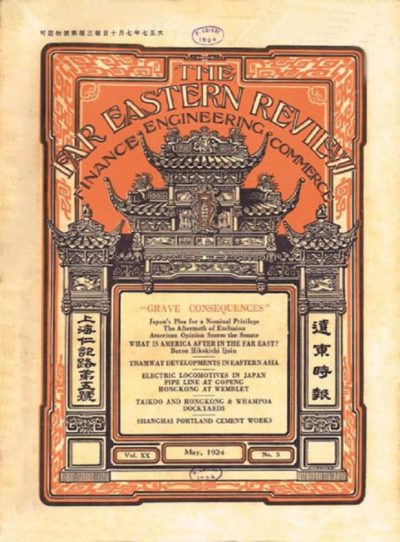
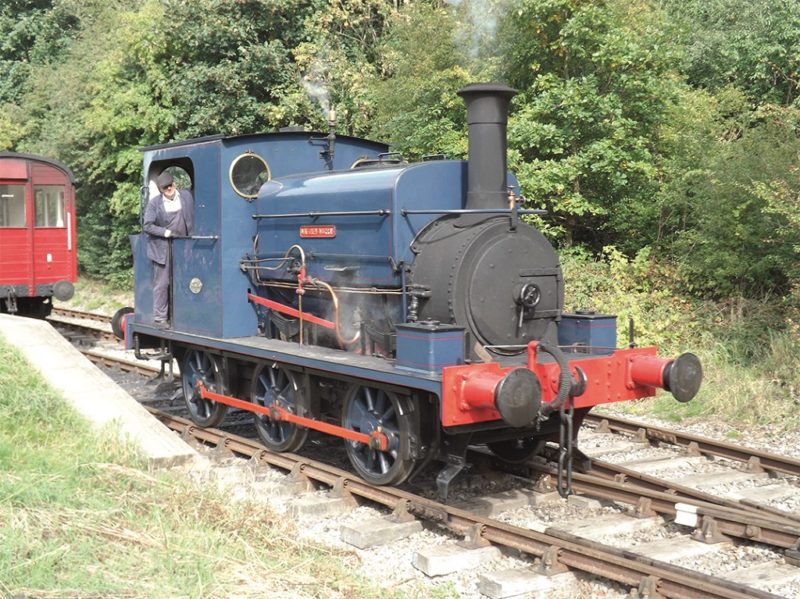
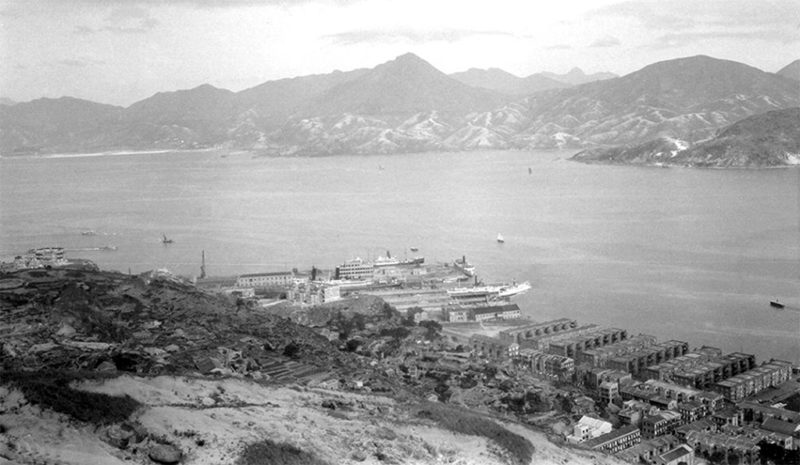

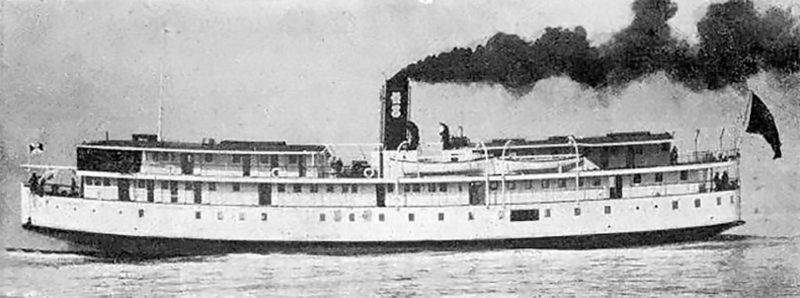
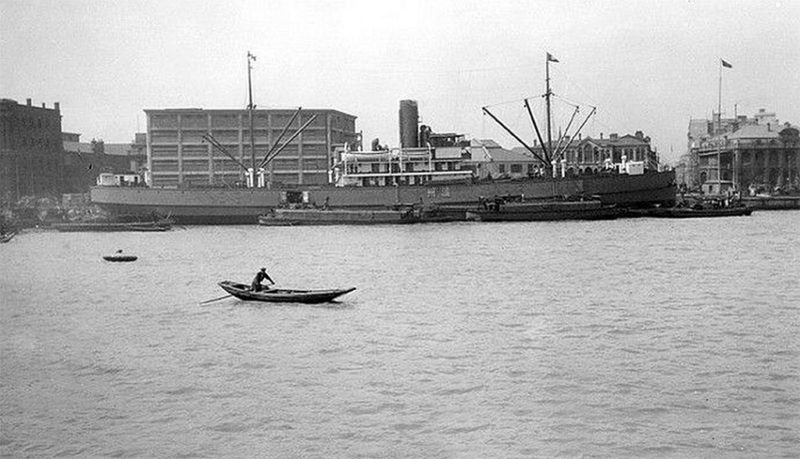
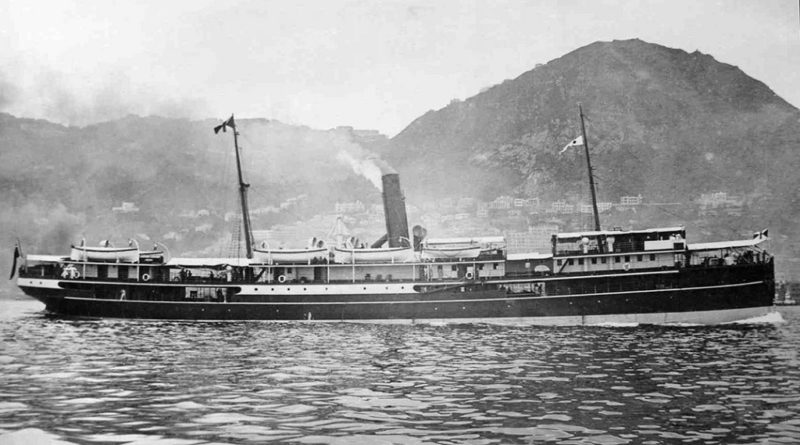
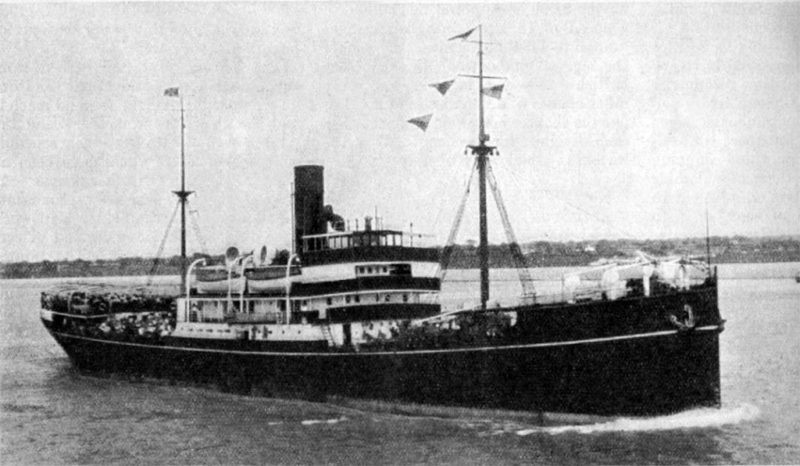
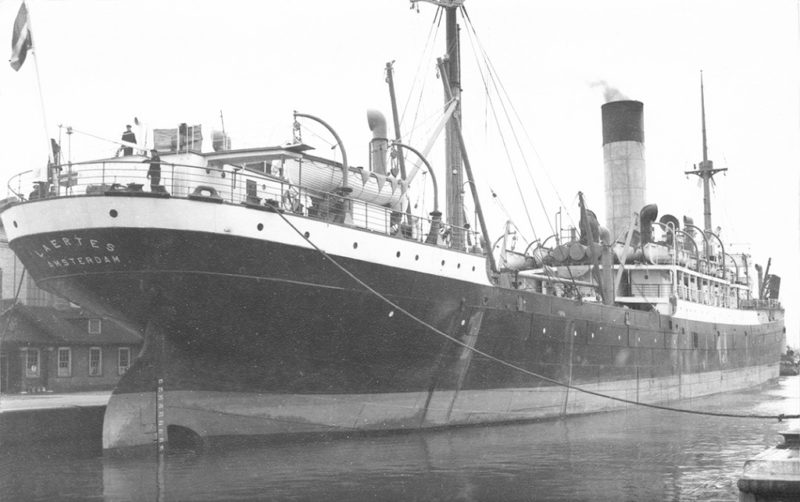
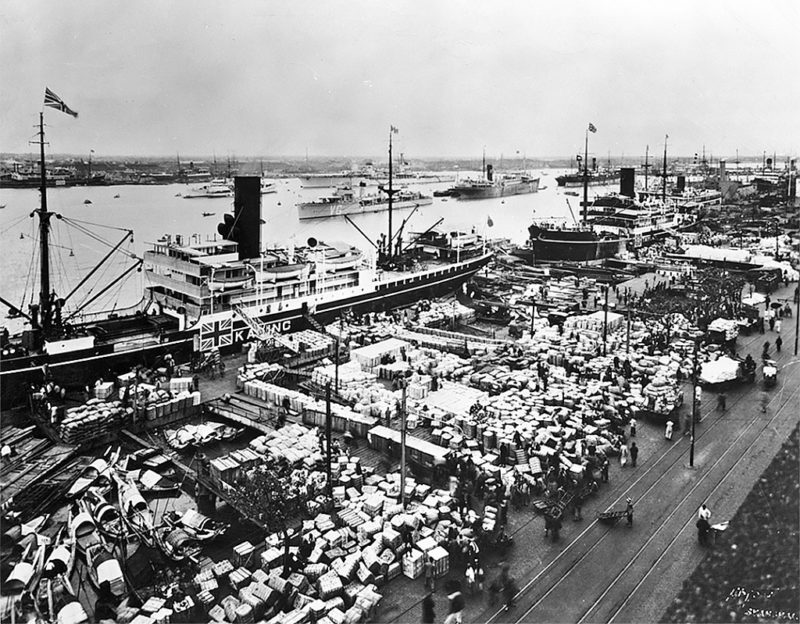
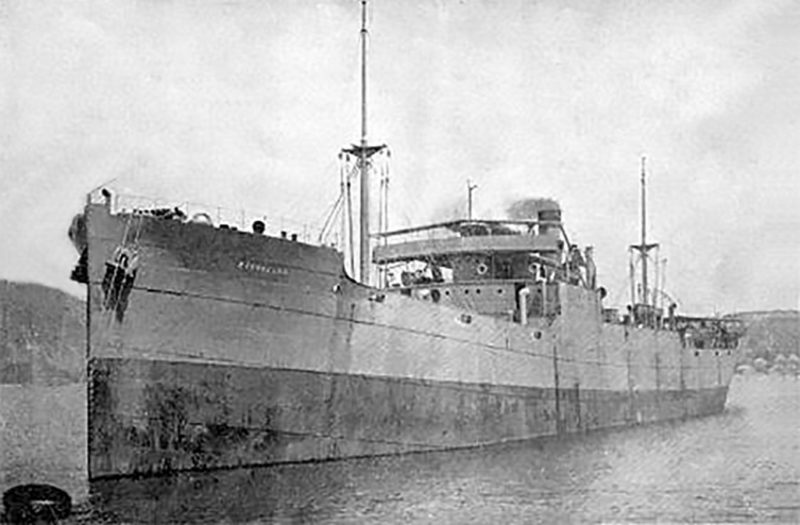
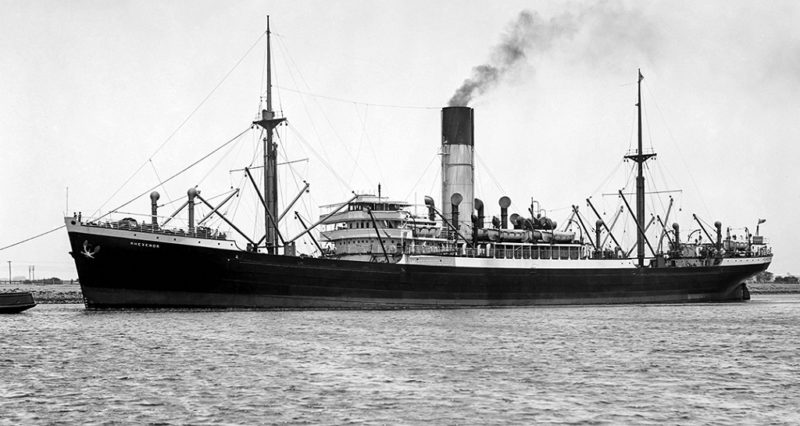
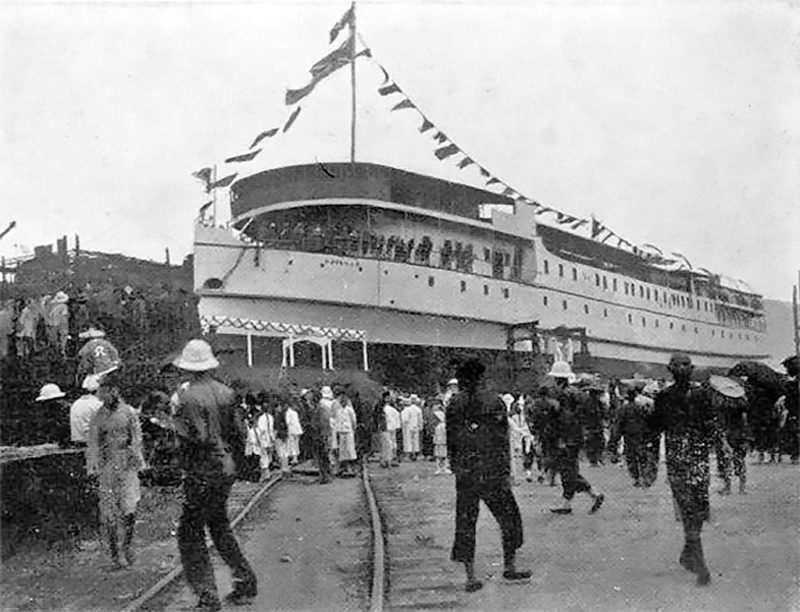
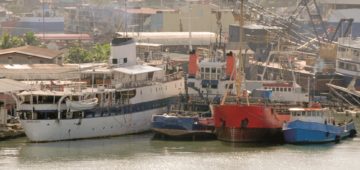


Comments
Sorry, comments are closed for this item